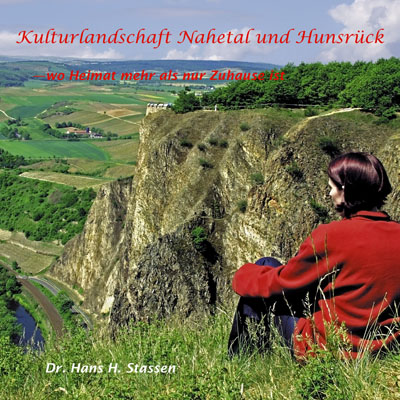
|

|

|

|
Unique Cultural Heritage: Nahe Valley and HunsrückNo question about this: very few non-locals can do something with "Nahetal" and do not connect "Hunsrück" with an old cultural landscape, but with the "Hahn" airport, which handles almost 5 million passengers to European holiday areas every year. However, locals sometimes have a hard time when it comes to history, country and people, geographical and geological features, or sights of the Nahe-Hunsrück region. Actually a shame, because Nahetal and Hunsrück are a millennia-old cultural landscape that comes up with an abundance of remarkable things — so you take your time. Dr. Hans H. Stassen, who grew up in the Nahe Valley and has been living in Switzerland for 35 years, took this time literally. During 3 years he visited 100 important places of the Nahe-Hunsrück region in all seasons and documented them photographically from different points of view. With extensive literature research, he has also compiled many small details which, as small mosaic stones, shape the image of the ancient cultural landscape along the Nahe and in Hunsrück. The result is a well readable, richly illustrated book with a wealth of background information, hints and suggestions that are equally interesting for locals and visitors alike. The reader learns from many details how strongly the region was shaped by Celtic, Roman and Franconian influences, which one can still encounter at every turn today. And the many preserved castles and palaces bear witness to an eventful history during the Middle Ages. Important people such as the mystic Hildegard von Bingen, the humanist Johannes Trithemius and the science theorist Nicolaus Cusanus worked here. In other words, people who lived hundreds of years ago, but whose works are still world-famous to this day. Thanks to rich iron ore deposits and charcoal, the Hunsrück already developed into an important European economic area with close trade ties to the Etruscans in Italy in the Celtic period. And on the upper Nahe, agates that were created 235 million years ago were mined for over 500 years. No other find area in Europe is characterized by such a wide variety of different shapes and colors of these semi-precious stones. In fact, the Nahetal and Hunsrück are one of the most geologically interesting areas in Germany and the region of the Lower Nahe with an annual mean of 9.5 degrees Celsius is one of the warmest and driest areas in Germany. No wonder that wine has been cultivated here since Roman times. Here are the largest contiguous forest areas in Germany, where the legendary hunter from the Palatinate had his hunting ground and the notorious robber captain Schinderhannes was up to mischief. Untouched nature invites you to take long hikes everywhere. Not to forget the typical Hunsrück villages with their churches and the world-famous Stumm organs —so named after the organ builder dynasty founded by Johann Michael Stumm (1683-1747) from Sulzbach am Idarkopf. It all seems to have a lot to do with old-fashioned "local history", one is tempted to think. Has it a bit too. But in a modern way that is geared to the needs of the modern leisure society. So why not make yourself comfortable in a deckchair and read about the unique cultural heritage as well as the recreational highlights of the Nahe Valley and the Hunsrück? |
|

ISBN: 3-00-017892-9 (178 Seiten, 190 Photos; € 19.95). Verlag Ars Nova, Am Maasberg 4a, D-55566 Bad Sobernheim; Tel: 06751-876'222, Fax: 06751-876'213 |
|
|
| [ Mail to Webmaster ] info@maasberg.ch |